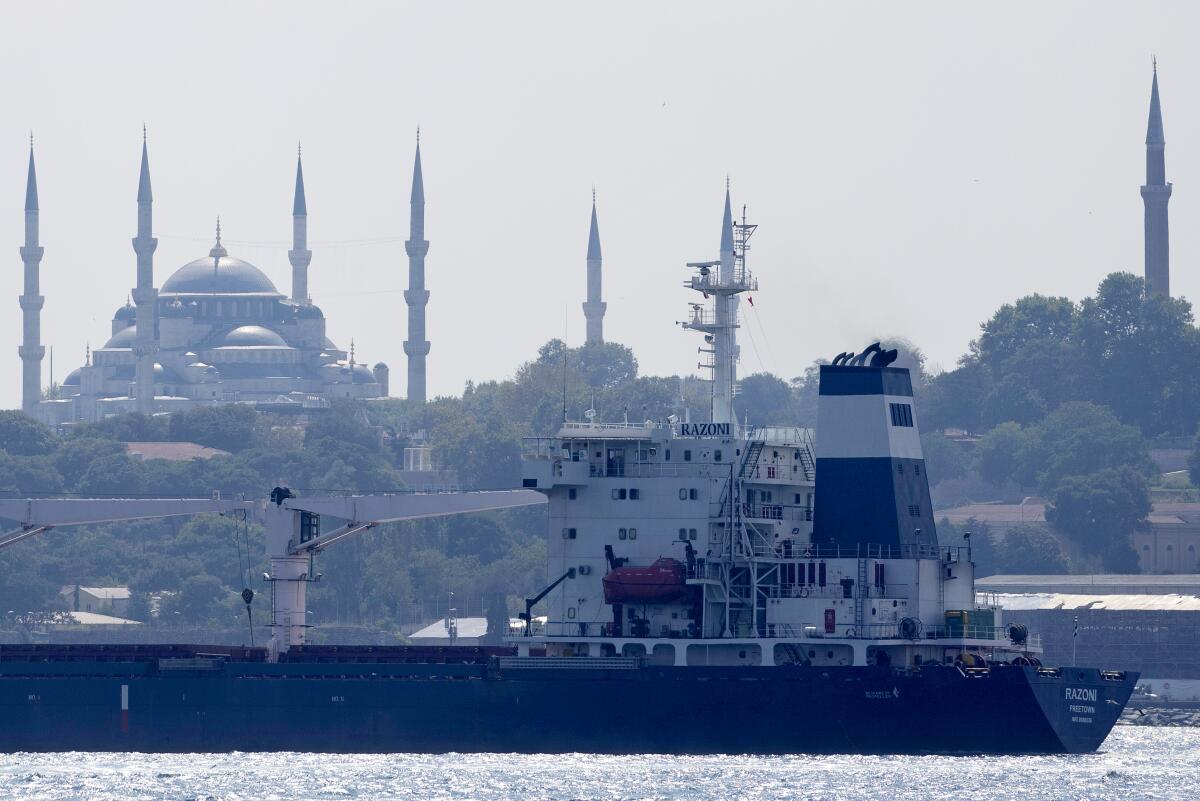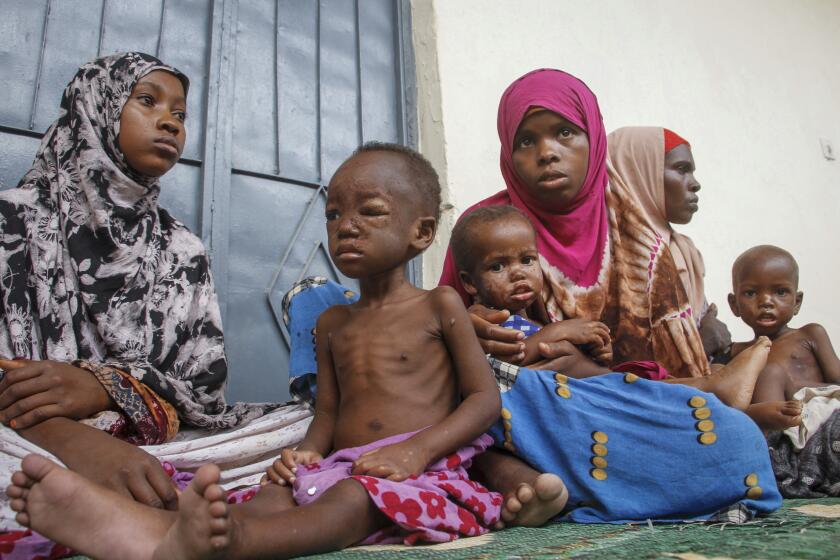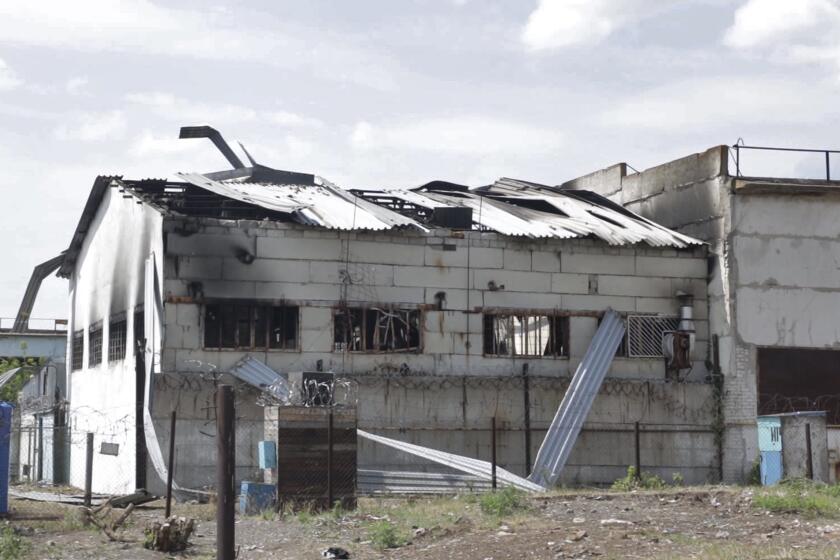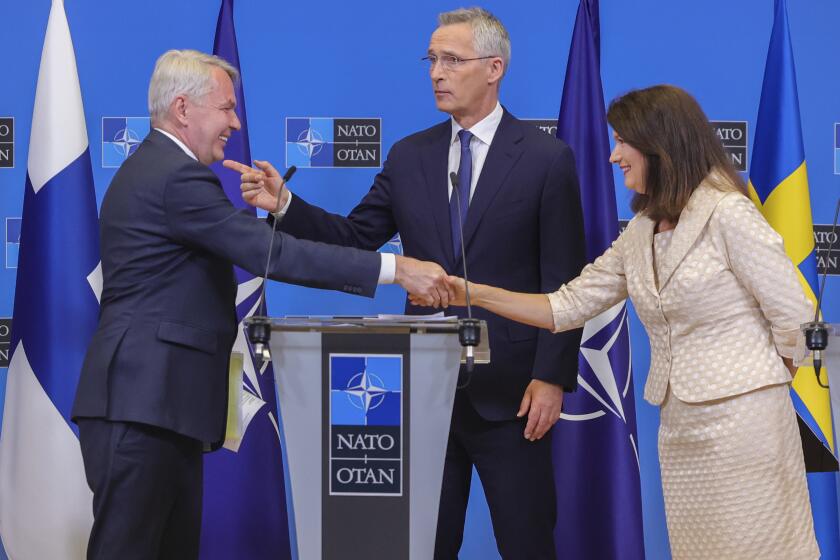Three more ships with grain leave Ukrainian ports under U.N.-brokered deal

- Share via
ISTANBUL — Three more ships carrying thousands of tons of corn left Ukrainian ports Friday, in the latest sign that a negotiated deal to export grain trapped since Russia invaded Ukraine nearly six months ago is slowly moving forward. But major hurdles lie ahead to get food to the countries that need it most.
The ships bound for Ireland, Britain and Turkey follow the first grain shipment to pass through the Black Sea since the start of the war. The passage of that vessel heading for Lebanon earlier this week was the first under the breakthrough deal brokered by Turkey and the United Nations with Russia and Ukraine.
The Black Sea region is dubbed the world’s breadbasket, with Ukraine and Russia key global suppliers of wheat, corn, barley and sunflower oil that millions of impoverished people in Africa, the Middle East and parts of Asia rely on for survival.
While the shipments have raised hopes of easing a global food crisis, much of the grain that Ukraine is trying to export is used for animal feed, not for people to eat, experts say. The first vessels to leave are among more than a dozen bulk carriers and cargo ships that had been loaded with grain but stuck in Ukraine’s ports since Russia invaded Feb. 24. And the cargoes are not expected to have a significant effect on the global price of corn, wheat and soybeans for several reasons.
For starters, the exports under the deal are off to a slow, cautious start because of the threat of explosive mines floating off Ukraine’s Black Sea coastline.
And while Ukraine is a major exporter of wheat to developing nations, there are other countries, such as the United States and Canada, with far greater production levels that can affect global wheat prices. They face the threat of drought.
Leading foreign ministers meet to confront global food insecurity crisis, facing conflict, climate change and COVID. Millions could die.
“Ukraine is about 10% of the international trade in wheat, but in terms of production it is not even 5%,” said David Laborde, an expert on agriculture and trade at the International Food Policy Research Institute in Washington.
The three ships left Friday with more than 58,000 tons of corn. Much of the grain that Ukraine exports is used as animal feed, experts say, but that is a fraction of the 20 million tons of grain that Ukraine says is trapped in the country’s silos and ports and that must be shipped out in order to make space for this year’s harvest.
Around 6 million tons of the trapped grain is wheat, but just half of that is for human consumption, Laborde said.
There is an expectation that Ukraine could produce 30% to 40% less grain over the coming next 12 months because of the war, though other estimates put that figure at 70%.
Tymophiy, 12, lost his mother and stepfather in a hail of Russian fire and is now in the care of relatives. His diary is a record of fury and grief.
Prices of grains peaked in the first weeks after Russia’s invasion, but some have since come down to their pre-war levels. Corn prices are running about 70% above the levels seen at the end of February 2020, before the COVID-19 pandemic, according to Jonathan Haines, senior analyst and data and analytics firm, Gro Intelligence. He said wheat prices are currently 63% above the levels seen at the end of February this year, when the invasion was launched.
One reason prices remain high is the impact of drought on harvests in North America, China and other regions, as well as the higher price of fertilizer needed for farming.
“When fertilizer prices are high, farmers may use less fertilizer. And when they use less fertilizer, they will produce less. And if they will produce less, supply will continue to remain insufficient,” Laborde said.
The three ships that departed Ukraine on Friday give hope that exports will ramp up to developing nations, where many are facing the increased threat of food shortages and hunger.
A strike last week in a separatist region of eastern Ukraine killed dozens of Ukrainian prisoners of war.
“The movement of three additional vessels overnight is a very positive sign and will continue to build confidence that we’re moving in the right direction,” Haines said. “If the flow of grain from Ukraine continues to expand, it will help relieve global supply constraints.”
The Turkish-flagged Polarnet, carrying 12,000 tons of corn, left the Chornomorsk port bound for Karasu, Turkey. The Panama-flagged Navi Star left Odesa’s port for Ireland with 33,000 tons of corn. The Maltese-flagged Rojen left Chornomorsk for Britain laden with more than 13,000 tons of corn, according to the U.N.
It added that the Joint Coordination Center — run by officials from Ukraine, Russia, Turkey and the U.N. overseeing the deal signed in Istanbul last month — authorized the three ships and inspected a ship headed for Ukraine. The Barbados-flagged Fulmar S was inspected in Istanbul and is headed for the Chornomorsk port.
The checks seek to ensure that outbound cargo ships carry only grain, fertilizer or food and not any other commodities, and that inbound ships are not carrying weapons. The vessels are accompanied by Ukrainian pilot ships for safe passage because of explosive mines strewn in the Black Sea.
Breaking News
Get breaking news, investigations, analysis and more signature journalism from the Los Angeles Times in your inbox.
You may occasionally receive promotional content from the Los Angeles Times.
After Turkey, which has relations with both Russia and Ukraine, helped broker the food deal two weeks ago, Turkish President Recep Tayyip Erdogan was to meet Russian President Vladimir Putin later Friday in Sochi, Russia. That meeting follows another face-to-face meeting the two leaders had in Iran three weeks ago.
The grain exports took place as the war continued to claim lives in Ukraine.
The Ukrainian presidential office said at least eight civilians were killed and 16 others were wounded in the latest Russian shelling.
The eastern Donetsk region has been facing the most intensive Russian barrage, and Donetsk Gov. Pavlo Kyrylenko repeated his call for all residents to evacuate.
U.S. senators delivered overwhelming bipartisan approval to NATO membership for Finland and Sweden.
“Shellings and bombings are going round the clock, and people who refuse to evacuate risk being killed on their pillows,” Kyrylenko said in televised remarks.
In Ukraine’s second-largest city, Kharkiv, three districts have come under massive shelling. Several apartment buildings and a street market were damaged, and three people were wounded.
Russian shelling also targeted the city of Zaporizhzhia and several towns along the front line in the region. For a second consecutive day, the Russians shelled the city of Nikopol facing the Zaporizhzhia nuclear power plant across the Dnieper River. Dozens of houses were damaged.
The Russians also hit the southern city of Mykolaiv.
More to Read
Sign up for Essential California
The most important California stories and recommendations in your inbox every morning.
You may occasionally receive promotional content from the Los Angeles Times.













